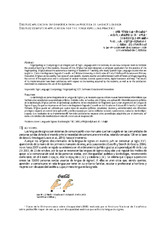Mostrar el registro sencillo del ítem
Dígitus: aplicación informática para la práctica de la dactilología
| dc.contributor.author | Vilches Vilela, M. Josefa | |
| dc.contributor.author | Fernández García, Nicolás Luis | |
| dc.contributor.author | Pavón Trujillo, Rafael | |
| dc.contributor.author | Navas-Chaveli Daza, Juan Luis | |
| dc.contributor.author | Llamas Castaño, Helena | |
| dc.date.accessioned | 2018-06-11T07:20:32Z | |
| dc.date.available | 2018-06-11T07:20:32Z | |
| dc.date.issued | 2017 | |
| dc.identifier.issn | 2531-1336 | |
| dc.identifier.uri | http://hdl.handle.net/10396/16896 | |
| dc.description.abstract | La dactilología es parte integrante de la Lengua de Signos y es necesario que se utilicen nuevas herramientas informáticas que faciliten a los estudiantes su aprendizaje práctico. Debido a ello, se ha diseñado Dígitus, una aplicación informática para la práctica de la dactilología. Dígitus permite el aprendizaje autónomo de los estudiantes de Magisterio que cursan asignaturas de Lengua de Signos Española que se imparten en el Centro de Magisterio Sagrado Corazón en los Grados en Educación Infantil y Educación Primaria. Dígitus puede ser utilizada por cuatro tipos de usuarios (público, estudiante, docente y administrador) con diferentes privilegios respecto al control de la aplicación y está compuesta por varios módulos: tutorial, cuestionarios, traductor dactilológico y ayuda. Los resultados de su implementación han sido satisfactorios respecto a los aprendizajes adquiridos por el alumnado, así como a la satisfacción manifestada en relación con el uso de la aplicación. | es_ES |
| dc.description.abstract | Fingerspelling or Dactylology is an integral part of Sign Language and it is necessary to use new computer tools to facilitate the practical learning of the students. Because of this, Dígitus has been designed, a computer application for the practice of the fingerspelling. Dígitus allows the autonomous learning of students of Teaching who study Spanish Sign Language courses that are taught in “Centro de Magisterio Sagrado Corazón” at Córdoba University, in the Grades of Early Childhood Education and Primary Education. Dígitus can be used by four types of users (public, student, teacher and administrator) with different privileges regarding the control of the application and is composed of several modules: tutorial, questionnaires, digital translator and help. The results of its implementation have been satisfactory with respect to the learning acquired by the students, as well as to the satisfaction manifested in relation to the use of the application. | es_ES |
| dc.format.mimetype | application/pdf | es_ES |
| dc.language.iso | spa | es_ES |
| dc.publisher | UCOPress | es_ES |
| dc.rights | https://creativecommons.org/licenses/by-nc-nd/4.0/ | es_ES |
| dc.source | Revista de innovación y buenas prácticas docentes 2, 58-67 (2017) | es_ES |
| dc.subject | Lengua de signos | es_ES |
| dc.subject | Dactilología | es_ES |
| dc.subject | TIC | es_ES |
| dc.subject | Software | es_ES |
| dc.subject | Innovación educativa | es_ES |
| dc.subject | Sign Language | es_ES |
| dc.subject | Dactylology | es_ES |
| dc.subject | Fingerspelling | es_ES |
| dc.subject | ICT | es_ES |
| dc.subject | Software | es_ES |
| dc.subject | Educational Innovation | es_ES |
| dc.title | Dígitus: aplicación informática para la práctica de la dactilología | es_ES |
| dc.title.alternative | Digitus: computer application for the fingerspelling practice | es_ES |
| dc.type | info:eu-repo/semantics/article | es_ES |
| dc.relation.publisherversion | http://www.uco.es/ucopress/ojs/index.php/ripadoc/index | es_ES |
| dc.rights.accessRights | info:eu-repo/semantics/openAccess | es_ES |

